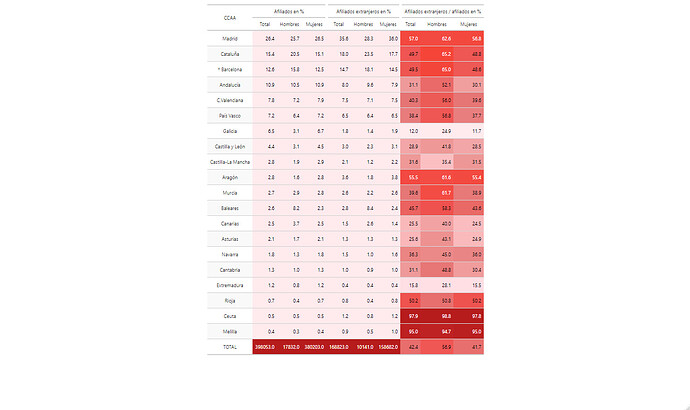Hello,
I have created a gt table using the function data_color to fill in the cells with a palette. However, I do not want to color the final row, which in most cases reflects the n of the column, while the other rows reflect percentages.This completely distorts my table as I get one cell per column filled with a dark red color while the rest are filled with a light red shade. I would greatly appreciate any advice on how to solve this issue. This is the code I used for the table, I have attached a picture of it at the end of the post:
CCAA = c("Madrid", "Cataluña", "* Barcelona", "Andalucía", "C.Valenciana",
"País Vasco", "Galicia", "Castilla y León", "Castilla-La Mancha", "Aragón",
"Murcia", "Baleares", "Canarias", "Asturias", "Navarra", "Cantabria",
"Extremadura", "Rioja", "Ceuta", "Melilla", "TOTAL")
total1 <- c(26.4, 15.4, 12.6, 10.9, 7.8, 7.2, 6.5, 4.4, 2.8, 2.8,
2.7, 2.6, 2.5, 2.1, 1.8, 1.3, 1.2, 0.7, 0.5, 0.4, 398053)
hombres1 <- c(25.7, 20.5, 15.8, 10.5, 7.2, 6.4, 3.1, 3.1, 1.9, 1.6,
2.9, 8.2, 3.7, 1.7, 1.3, 1.0, 0.8, 0.4, 0.5, 0.3, 17832)
mujeres1 <- c(26.5, 15.1, 12.5, 10.9, 7.9, 7.2, 6.7, 4.5, 2.9, 2.8,
2.8, 2.3, 2.5, 2.1, 1.8, 1.3, 1.2, 0.7, 0.5, 0.4, 380203)
total2<- c(35.6, 18.0, 14.7, 8.0, 7.5, 6.5, 1.8, 3.0, 2.1, 3.6, 2.6,
2.8, 1.5, 1.3, 1.5, 1.0, 0.4, 0.8, 1.2, 0.9, 168823)
hombres2 <- c(28.3, 23.5, 18.1, 9.6, 7.1, 6.4, 1.4, 2.3, 1.2, 1.8,
2.2, 8.4, 2.6, 1.3, 1.0, 0.9, 0.4, 0.4, 0.8, 0.5, 10141)
mujeres2 <- c(36.0, 17.7, 14.5, 7.9, 7.5, 6.5, 1.9, 3.1, 2.2, 3.8,
2.6, 2.4, 1.4, 1.3, 1.6, 1.0, 0.4, 0.8, 1.2, 1.0, 158682)
total3 <- c(57.0, 49.7, 49.5, 31.1, 40.3, 38.4,12.0, 28.9, 31.6, 55.5,
39.6,45.7,25.5,25.6,36.3,31.1,15.8,50.2,97.9,95.0,42.4)
hombres3 <- c(62.6,65.2,65.0,52.1,56.0,56.8,24.9,41.8,35.4,61.6,
61.7,58.3,40.0,43.1,45.0,48.8,28.1,50.8,98.8,94.7,56.9)
mujeres3 <- c(56.8,48.8,48.6,30.1,39.6,37.7,11.7,28.5,31.5,55.4,
38.9,43.6,24.5,24.9,36.0,30.4,15.5,50.2,97.8,95.0,41.7)
dat <- data.frame(CCAA, total1, hombres1, mujeres1, total2, hombres2, mujeres2, total3, hombres3, mujeres3)
dat %>%
gt() %>%
tab_spanner(
label = "Afiliados en %",
columns = vars(total1,hombres1,mujeres1)) %>%
tab_spanner(
label = "Afiliados extranjeros en %",
columns = vars(total2, hombres2, mujeres2)) %>%
tab_spanner(
label = "Afiliados extranjeros / afiliados en %",
columns = vars(total3, hombres3, mujeres3)) %>%
cols_label(total1 = "Total",
hombres1 ="Hombres",
mujeres1="Mujeres",
total2="Total",
hombres2="Hombres",
mujeres2="Mujeres",
total3="Total",
hombres3="Hombres",
mujeres3="Mujeres") %>%
data_color(columns=vars(total1, hombres1, mujeres1,total2, hombres2, mujeres2,total3, hombres3, mujeres3),
colors = scales::col_numeric(
palette = as.character(paletteer::paletteer_d(palette = "ggsci::red_material")),
domain = NULL))

